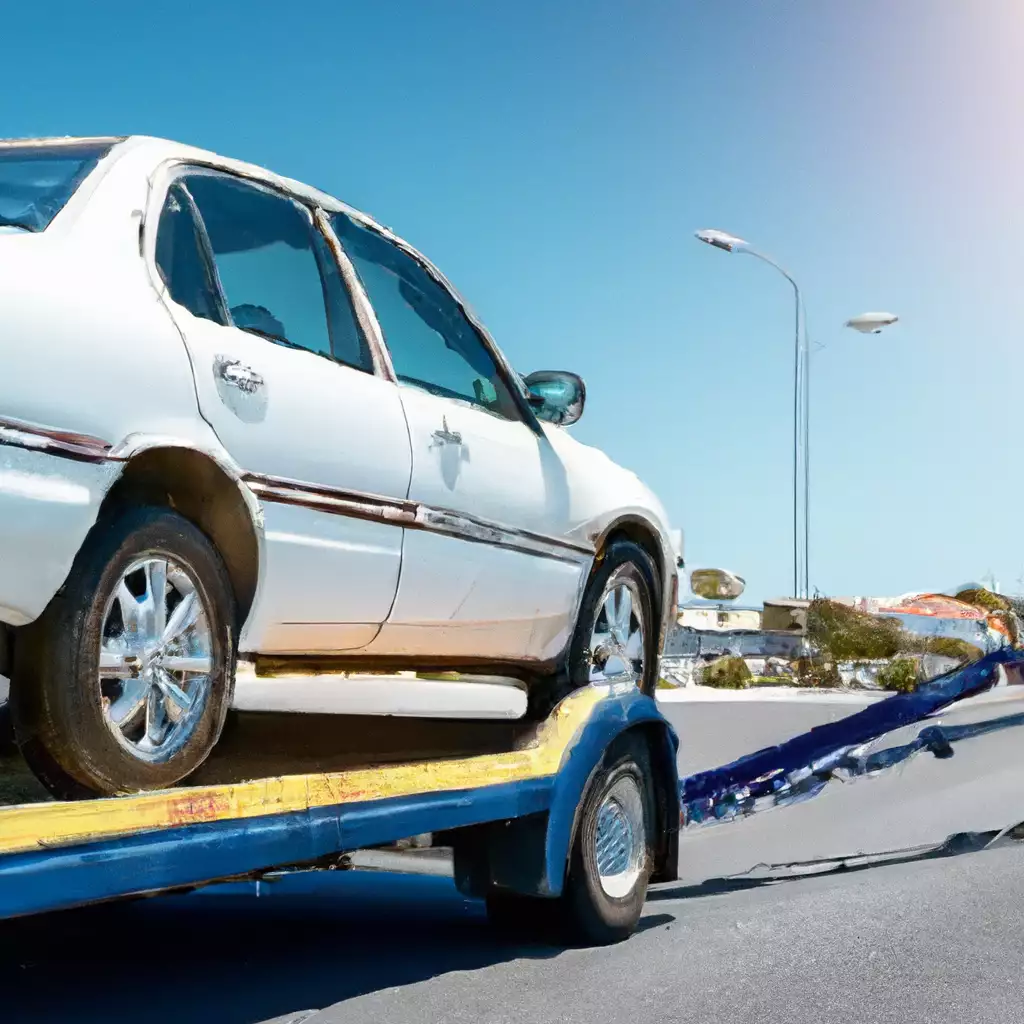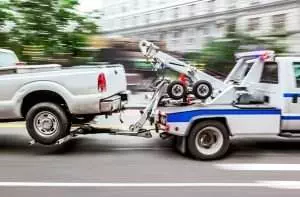If you’re looking to transport a vehicle behind another vehicle, you may have come across the term “flat towing.” But what exactly does this mean? Flat towing, also known as dinghy towing or four-down towing, refers to the process of towing a vehicle with all four wheels on the ground, without the need for a trailer. This method is widely used for recreational vehicles (RVs) and allows for a more convenient and efficient way to travel with a second vehicle. In this article, we will explore the ins and outs of flat towing, including its benefits, equipment requirements, and important considerations to ensure a safe and successful journey.

What is Flat Towing?
Flat towing, also known as dinghy towing or four-down towing, is a method of towing a vehicle behind a motorhome or recreational vehicle (RV) without using a trailer or a dolly. In flat towing, the towed vehicle is directly connected to the towing vehicle, allowing it to be pulled with all four wheels on the ground. This method of towing is popular among RV enthusiasts and travelers as it offers convenience and versatility. However, it requires proper equipment, vehicle compatibility, and adherence to safety guidelines.
Understanding Flat Towing
Definition of Flat Towing
Flat towing refers to the practice of pulling a vehicle behind a motorhome or RV using a tow bar or towing system, with all four wheels of the towed vehicle in contact with the ground. It allows the towed vehicle to be maneuvered and controlled by the towing vehicle, eliminating the need for a separate trailer or dolly.
Purpose of Flat Towing
The primary purpose of flat towing is to bring along a secondary vehicle for exploration and transportation purposes while traveling with a motorhome or RV. It provides the freedom to easily disconnect the vehicle and use it for local commuting, sightseeing, shopping, or running errands. Flat towing is commonly utilized by RV owners who want to have a separate vehicle available for their needs without the hassle of towing a larger trailer or using a dolly.
Flat Towing Vs. Other Towing Methods
Flat Towing vs. Dolly Towing
Flat towing differs from dolly towing in that it does not require a separate dolly to lift the towed vehicle’s front or rear wheels off the ground. Instead, all four wheels of the towed vehicle remain in contact with the pavement. This eliminates the need for a dolly, reducing the overall weight and complexity of the towing setup. Flat towing also provides better stability and maneuverability compared to dolly towing.
Flat Towing vs. Trailer Towing
Unlike trailer towing, where the entire towed vehicle is loaded onto a trailer, flat towing allows the towed vehicle to be directly connected to the towing vehicle. This method eliminates the need for a separate trailer, reducing the overall length and weight of the towing configuration. Flat towing offers improved maneuverability and eliminates issues such as trailer sway, backing up, or storing a trailer when not in use.

Equipment and Set-Up for Flat Towing
To successfully flat tow a vehicle, several essential pieces of equipment need to be installed and utilized properly. It is crucial to invest in high-quality and compatible towing equipment to ensure safety and efficiency during the towing process.
Tow Bar
The tow bar is the primary component used to connect the towing vehicle and the towed vehicle. It is a rigid steel bar that attaches to the base plates installed on the towed vehicle. The tow bar is designed to distribute the weight and forces evenly between the towing vehicle and the towed vehicle, allowing for smooth towing.
Base Plates
Base plates are custom-designed brackets that are mounted to the frame of the towed vehicle. They serve as the anchor points for attaching the tow bar. Base plates should be installed by a professional and should be compatible with both the towed vehicle and the tow bar being used.
Safety Cables
Safety cables are an essential safety feature in case the tow bar or the towing connection fails. These cables provide a secondary attachment between the towing vehicle and the towed vehicle, acting as a backup in the event of a failure. It is important to ensure that the safety cables are properly installed and have an appropriate weight rating.
Wiring Kit
A wiring kit is necessary to establish electrical connections between the towing vehicle and the towed vehicle. It includes wiring harnesses, connectors, and cables to transfer signals for the towed vehicle’s lights, turn signals, and brake lights. This ensures that the towed vehicle’s lighting functions properly, enhancing safety and legal compliance.
Supplemental Braking System
A supplemental braking system is highly recommended to ensure effective braking while flat towing. This system applies the brakes of the towed vehicle simultaneously with the towing vehicle, reducing stress on the towing vehicle’s braking system. It provides better control and shorter stopping distances, enhancing overall towing safety.
Selecting the Proper Vehicle for Flat Towing
Not all vehicles are suitable for flat towing. It is essential to consider certain factors and criteria when selecting a vehicle for this towing method.
Vehicle Fit for Flat Towing
A vehicle suitable for flat towing should have manufacturer-approved towing provisions and be specifically designed for this purpose. Some vehicles are pre-equipped with base plates or tow bar attachment points, making them easier to tow without extensive modifications.
Weight Considerations
It is crucial to consider the weight of the towed vehicle in relation to the towing vehicle’s capacity. Exceeding the towing vehicle’s weight limits can lead to instability, reduced braking efficiency, and increased wear and tear on both vehicles. It is important to consult the manufacturer’s guidelines and tow ratings to ensure proper weight distribution and safe towing conditions.
Transmission and Drive System Requirements
Certain vehicles are not suitable for flat towing due to limitations with their transmission or drive system. Vehicles with automatic transmissions may require additional steps, such as installing a transmission lubrication pump, to ensure proper lubrication while being towed. Four-wheel drive vehicles may require specific procedures to engage the transfer case in a neutral position. It is vital to consult the vehicle manufacturer’s guidelines to determine if a specific vehicle is suitable for flat towing.
Preparing the Vehicle for Flat Towing
Before embarking on a flat towing journey, it is essential to prepare both the towing vehicle and the towed vehicle for a safe and hassle-free experience.
Read the Owner’s Manual
Thoroughly reading the owner’s manuals of both the towing vehicle and the towed vehicle is crucial. These manuals provide important information and instructions specific to each vehicle, including recommended towing procedures, weight limits, and any additional requirements or precautions.
Disconnect and Secure Components
Certain components of the towed vehicle need to be disconnected or secured before flat towing. This may include removing key fobs, ensuring the gearshift is in neutral, disabling the steering lock, and securing loose items within the vehicle to prevent damage. Following the manufacturer’s guidelines and recommendations is essential to avoid any potential issues or damage during towing.
Preparing the Towing Vehicle
The towing vehicle should also be prepared for flat towing. This may involve ensuring that the towing capacity of the vehicle is not exceeded, adjusting tire pressures for optimal towing conditions, and making sure all towing components and attachments are securely fastened and in good working condition.
Procedure for Flat Towing
Proper procedure is crucial during the actual process of flat towing to ensure safety and prevent any damage to the vehicles involved.
Attaching the Towing Vehicle
To begin flat towing, the towing vehicle and the towed vehicle need to be properly aligned. The tow bar should be attached to the base plates on the towed vehicle, ensuring a secure and stable connection. The tow bar should be level and parallel to the ground, minimizing stress on the towing system.
Securing the Connection
Once the tow bar is securely attached, safety cables should be connected, crisscrossing them for added security. These cables act as a backup in case the tow bar fails. The electrical connections for lights and signals should also be securely connected, ensuring proper functionality throughout the towing process.
Testing the Towing Configuration
Before hitting the road, it is important to conduct a thorough test of the towing configuration. This includes checking that all lights and signals on the towed vehicle are functioning correctly, verifying that the braking system is operational, and ensuring that the towed vehicle tracks properly behind the towing vehicle. Any issues or abnormalities should be addressed and resolved before continuing with the towing journey.
Safety Considerations and Best Practices
Ensuring safety during flat towing is of utmost importance. Adhering to certain guidelines and best practices can significantly enhance the towing experience and minimize the risk of accidents or damage.
Maintaining Proper Towing Speeds
It is essential to maintain safe and reasonable speeds while flat towing. Excessive speed can increase the risk of accidents and compromise vehicle control. It is recommended to follow any speed restrictions imposed by local laws or regulations and to travel at a speed that allows for safe stopping distances and maneuverability.
Monitoring the Towed Vehicle
Regularly monitoring the towed vehicle during the towing journey is crucial. Keeping an eye on the towed vehicle’s tires, ensuring they are properly inflated and not showing signs of unusual wear, can help prevent tire blowouts. Periodically checking the towed vehicle’s lights and signals for proper functionality is important to maintain visibility and communicate driving intentions to other motorists.
Regular Safety Inspections
Performing regular safety inspections before and during the towing journey is essential to identify and address any potential issues or malfunctions. This includes inspecting the tow bar, base plates, safety cables, wiring connections, and the supplemental braking system. Any signs of wear, damage, or improper functioning should be promptly addressed and repaired to ensure safe towing conditions.
Legal and State Requirements for Flat Towing
When engaging in flat towing, it is essential to be aware of the legal and state requirements to ensure compliance and avoid potential legal issues.
Towing Regulations and Restrictions
Different states and jurisdictions may have specific regulations and restrictions regarding flat towing, such as speed limits, maximum weights, and specific requirements for equipment and lighting. It is important to research and familiarize yourself with the applicable laws and regulations in the areas where you will be towing to avoid any legal consequences.
Licensing and Registration
Some states may require additional licensing, permits, or registration for vehicles being flat towed. It is important to check with the appropriate authorities to determine if any additional requirements are necessary before embarking on a flat towing journey.
Benefits and Limitations of Flat Towing
While flat towing offers several benefits, there are also certain limitations and considerations to keep in mind.
Convenience and Versatility
Flat towing allows for easy and convenient transportation of a secondary vehicle without the need for a trailer or dolly. It provides the flexibility to disconnect the towed vehicle for local commuting or exploration, offering greater versatility during RV travel.
Overcoming Limitations
Certain vehicles may not be suitable for flat towing due to their design, weight, or transmission limitations. It is important to carefully consider these factors when selecting a vehicle for flat towing. Additionally, flat towing may put additional strain on the towing vehicle’s engine and braking systems. Proper maintenance, adherence to weight limits, and use of supplemental braking systems can help mitigate these limitations.
In conclusion, flat towing is a popular and convenient method of towing a vehicle behind an RV or motorhome. It offers the freedom to bring along a secondary vehicle for exploration and transportation purposes while eliminating the need for a separate trailer or dolly. Proper equipment, vehicle compatibility, and adherence to safety guidelines are essential for a successful and safe flat towing experience. By understanding the requirements, preparing the vehicles adequately, and following best practices, flat towing can be an efficient and enjoyable way to enhance the travel experience for RV enthusiasts.



